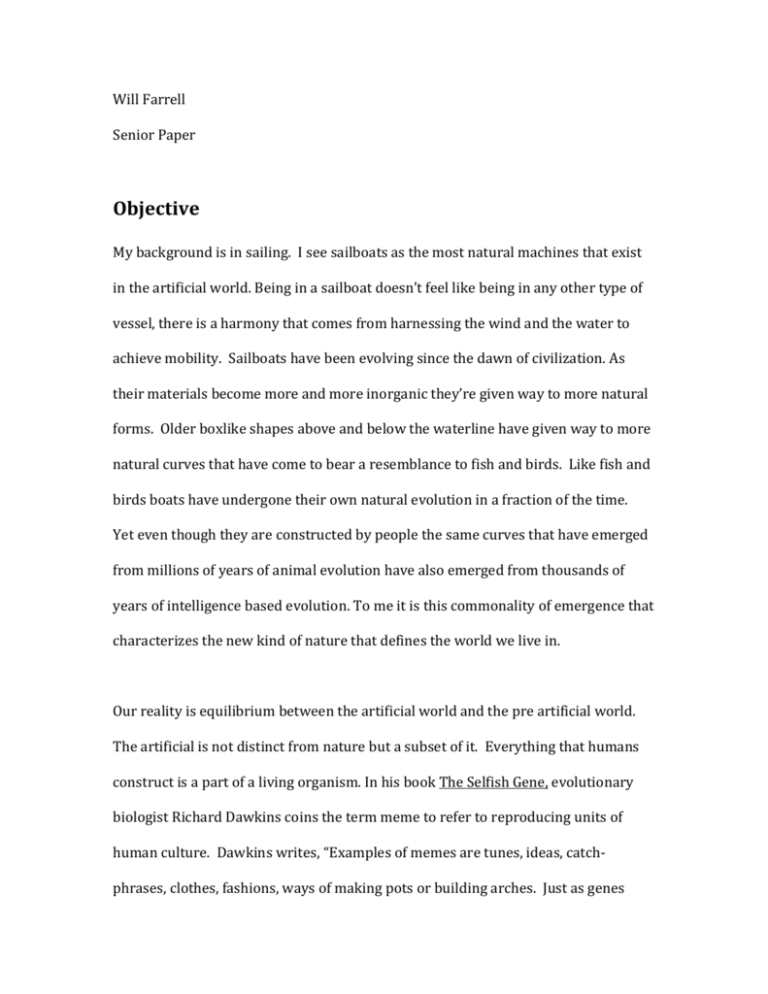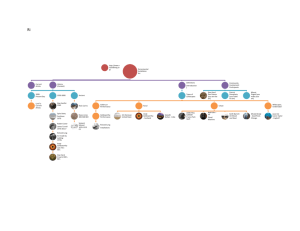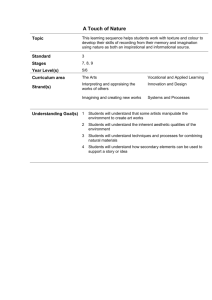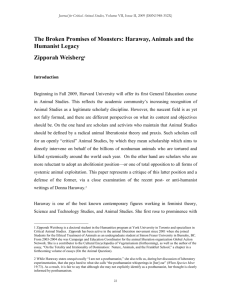Rough Draft of the first half of my senior paper
advertisement

Will Farrell Senior Paper Objective My background is in sailing. I see sailboats as the most natural machines that exist in the artificial world. Being in a sailboat doesn’t feel like being in any other type of vessel, there is a harmony that comes from harnessing the wind and the water to achieve mobility. Sailboats have been evolving since the dawn of civilization. As their materials become more and more inorganic they’re given way to more natural forms. Older boxlike shapes above and below the waterline have given way to more natural curves that have come to bear a resemblance to fish and birds. Like fish and birds boats have undergone their own natural evolution in a fraction of the time. Yet even though they are constructed by people the same curves that have emerged from millions of years of animal evolution have also emerged from thousands of years of intelligence based evolution. To me it is this commonality of emergence that characterizes the new kind of nature that defines the world we live in. Our reality is equilibrium between the artificial world and the pre artificial world. The artificial is not distinct from nature but a subset of it. Everything that humans construct is a part of a living organism. In his book The Selfish Gene, evolutionary biologist Richard Dawkins coins the term meme to refer to reproducing units of human culture. Dawkins writes, “Examples of memes are tunes, ideas, catchphrases, clothes, fashions, ways of making pots or building arches. Just as genes propagate themselves in the gene pool by leaping from body to body via sperm or eggs, so memes propagate themselves in the meme pool by leaping from brain to brain via a process which, in the broad sense, can be called imitation.” (Dawkins, 192) Memes are not unique to humans - bird tunes can replicate independent of genetics. Internet memes, computer viruses and software all exist in a cybernetic medium that is both human and machine. Stephanie Forrest, a computer scientist who worked on the Apache web server argues that a biological approach is necessary for developing a computerized immune system to protect against malicious code. In her essay “Computation in the Wild” she writes, “Successful individuals reproduce more frequently, passing on their genes to future generations. Similarly, in our software ecosystem, reproductive success is achieved when software is copied, and evolutionary dead-ends occur when a piece of software fails to be copied—as in components that are replaced (or “patched”) to correct errors or extend functionality.” (Forrest, 7) Through the medium of the human species, computer code functions as living matter that evolve as an extension of natural life. The human consciousness is a relationship between the artificial and organic, the memetic and genetic. If the ecosystem we live in is any reflection of that dynamic, then our perspective is completely out of balance. Although pollution can be perceived as evidence of human corruption of the environment I think it’s symptomatic of a bigger problem: we view ourselves as distinct from our environment. With my project I plan on growing an organic plant and an artificial plant in a symbiotic relationship with one another. The two will communicate with each other in a feedback loop becoming a part of a system that symbolizes humanity and our environment; both cybernetic entities. Context Computational differences between machines and nature. Natural and mechanical computers handle different types of data. Mechanical computers store data in the form of Natural numbers through binary strings of 0’s and 1’s. Nature One example that conveys this difference visually is the difference between measuring the lengths of natural objects as opposed to man made ones. Measuring something like the side of a building is a simple as taking a ruler, counting the number of times the ruler can fit across that side, and multiplying that number by the length of the ruler. A shorter ruler might allow for a more accurate measurement but for the most part the measurements should be similar. Measurement of a coastline however is a far more complicated problem. Measuring a coastline with two different sized rulers will give two completely different results. If a mile long ruler is used it will fail to take into account the jagged rocks of the jetties that elongate the coastline by bending it. If an inch long ruler is used it will fail to take into account the grains of sand that also bend and elongate the coastline. Coastlines are infinitely complex and attempts to represent them in discrete terms will always fall short. To measure the coastline with complete precision requires a ruler that is infinitely small being used an infinite number of times. If it were possible for a computer to attempt such a problem it would take an infinite amount of time to complete it (Flake, 57). In this metaphor the length of the building represents discrete data, the type that mechanical computers handle, and the length of the coastline represents continuous data, the type found in nature. Calculating irrational numbers such as the square root of 2 and pi is a similar process to measuring coastline. Mathematics constructs these numbers by applying a formula to a discrete number, getting the result, and then applying that same formula to the result recursively forever. To calculate these numbers with a conventional computer not only requires that the computer run forever but also makes it impossible for the computer to know it will run forever. The Mathematician Goerg Cantor was the first to discover the difference between these two types of numbers. He proved that there are an infinite and countable number of rational numbers (such as 2, 1/3, 4.5) but that the number of irrational numbers is not only infinite but also uncountable (Flake, 35). It’s important to note that there have been recent advances in computing that have been able to escape some of the limits of conventional computing. One example is the DNA computer and its ability to solve the traveling salesman problem. In this problem a traveling salesman must pick a path to visit a specified number of cities in the shortest path possible. As the number of cities increases the problem takes exponentially more time for a conventional computer to solve and the human brain begins to outperform the computer by picking shorter paths in less time. In 1994, Leonard M. Adleman a professor at the University of Southern California managed to solve this problem by using DNA nucleotides to represent the lengths between each possible city. Adleman synthesized strands of DNA that represented each possible overall route the salesman could take and picked the shortest one. This solution effectively gave Adelman the fastest computer at the time (Adelman, 3). Computer Based Models of Nature In 1967 Benoît B. Mandelbrot developed an effective method for measuring coastlines that involved using fractals to approximate their shape. Fractals are objects that exist in between dimensions, two and a half as opposed to three, and are similar to their parts. Nature is composed mostly of fractals in some form or another. Coastlines don’t appear to be self-similar but statistically they are (Mandlebrot, 29). Fractals are used to approximate a wide variety of forms in nature, particularly plants. Models of plants will vary greatly from one context to another. Biologists are more concerned with scientific data than visual appeal. Animators need their models to react to forces such as wind while rendering them realistically. The first simulations of growth stemmed from cellular automata, systems on a grid divided into cells that grow based on very simple rules. From these simple rules chaotic complexities can emerge that mimic nature. The biologist Astrid Lindenmayer developed a similar approach that represents the plant as a series of objects that change based on a set of simple mathematical rules. These objects can spawn more objects with different characteristics and after some time vast complexities can emerge out of a simple system (Deussen, 63). Biologists use Lindermayer systems to produce very accurate data about plant growth. When artists such as animators and videogame designers began representing plants with computers they used a myriad of approaches to visually convey computergenerated plants. Today most cinema production houses use the Xfrog software environment to develop ultra realistic looking models of nature (Deussen, 89). Xfrog uses a combinatorial approach based on L systems and cellular automata to create an end product that has an intuitive interface and creates plants that can be efficiently rendered. Since plants obey different rules at different scales, a hybridized approach is necessary. Since Xfrog doesn’t allow plants to grow, its users are mostly artists and not biologists. Some plant growth can be achieved by using keyframes to create different plant models for each frame that are slightly different than the previous ones. Cybernetics and Cyborgs Closely tied to the concept of emergence is the idea of cybernetics. Originally used by Plato in his treatise “The Laws,” cybernetics refers to the concept of intelligence materializing within a system arising from communication between many different interconnected parts. Plato originally used the term to describe the idea of government as an intelligence that emerges out of a mass of people. Today cybernetics is applied to many different subject areas ranging from artificial intelligence to biology. Through Cybernetics, artificial intelligence systems have the ability to learn and adapt to their environment based on the evolution of complexity from simple rule based systems. Machines no longer require people to adapt to their environment because systems are constantly changing themselves based on interior communication between their parts. Artificial intelligence can be generated by simple rules and initial data the same way that beautifully complex plants can be created from Lindenmayer systems and cellular automata. Modern humans live at the intersection between two types of cybernetic systems; the biological and the artificial. We’ve managed to reduce our biological systems into terms that we used to define our artificial systems. In “The Cyborg Manifesto” Donna Haraway writes, “In modern biologies, the translation of the world into a problem in coding can be illustrated by molecular genetics, ecology, sociobiological evolutionary theory, and immunobiology. The organism has been translated into problems of genetic coding and read-out. Biotechnology, a writing technology, informs research broadly. In a sense, organisms have ceased to exist as objects of knowledge, giving way to biotic components, i.e., special kinds of information-processing devices” (Haraway, 164). Haraway sees human beings as an extension of the integrated circuit in a constant biomechanical feedback loop. Computers are not a separate species but a part of the human identity. Haraway continues, “The machine is not an it to be animated, worshipped, and dominated. The machine is us, our processes, an aspect of our embodiment. We can be responsible for machines; they do not dominate or threaten us. We are responsible for boundaries; we are they” (Haraway, 181). To Haraway, the condition of the cyborg is a metaphor for the role of women in society. To her women can’t be defined by a “universal, transhistorical, necessary cause or constitution of gender identity or patriarchy". In Cybernetics intelligence cannot be defined distinctly from the communicative system in which it lives. Haraway makes the same argument for women. Andy Goldsworthy Situating his art to its specific environment, Andy Goldsworthy creates compositions from material he finds at the sites where he works. For him the process of creating his works is just as much a part of the piece as the final product. Goldsworthy’s media is inseparable from the environment. He chooses to work with found materials such as icicles, leaves, stones and anything natural that he finds on site. Most of the work is done with his bare hands but he uses a camera to capture the finished product on film. Even though the materials are natural the forms Goldsworthy creates are unmistakably man-made. In Collaborations with Nature, Goldsworthy writes “the ball, pitch, line, arch and spire are recurring forms in my work. It is as if I find myself in deep water and these forms are familiar rocks that I can always put a foot to. In that respect they are important and probably necessary” (Goldsworthy, 3). Geometrically these shapes are fairly simple. They are not the complex fractals that we see in coastlines and plants and are more frequently seen in urban settings than in nature. Despite the fact that all the materials are found at the site there is a distinct line between those works and the environment, they are not continuous extensions of nature but new discrete forms. Goldsworthy’s statement hints that he is grounded in civilization. He goes into a natural surrounding alone but keeps his artificial construction of the world with him. Like a pioneer’s flag planted atop a mountain peak, Goldsworthy’s work plants the distinct mark of civilization onto nature. Yet this distinction between his works and their surroundings is not one of opposition. The pieces live in harmony with their surroundings and pay tribute to the harsh realities of their setting. Spiral Jetty In this production Robert Smithson takes a very different approach to creating environmental art. Spiral Jetty, a 1,500 foot long jetty coiled up into a spiral, is environmental art on a much bigger scale produced by using dump trucks to unload rocks into the great salt lake. Jetties are meant to reduce turbulence in the water by breaking the waves, yet in this case Smithson uses them as a symbol of disorder. The New York Times writes, “He embraced the idea of entropy, accepting that his sculptures would change with the cycles of nature and the elements. His allusions were cosmological, postindustrial and primitive - to ancient civilizations and geological forms.” Rather than seeking to impose order upon the environment, Smithson takes the jetty and uses it to contribute to the disorder of the lake. 16 miles from the nearest paved road, Spiral Jetty is “about as remote as a sculpture can be within the contiguous United States.” For many years the Jetty had been completely submerged, only visible in droughts. This uncertainty of Spiral Jetty’s exhibition further integrates this piece into its environment.







